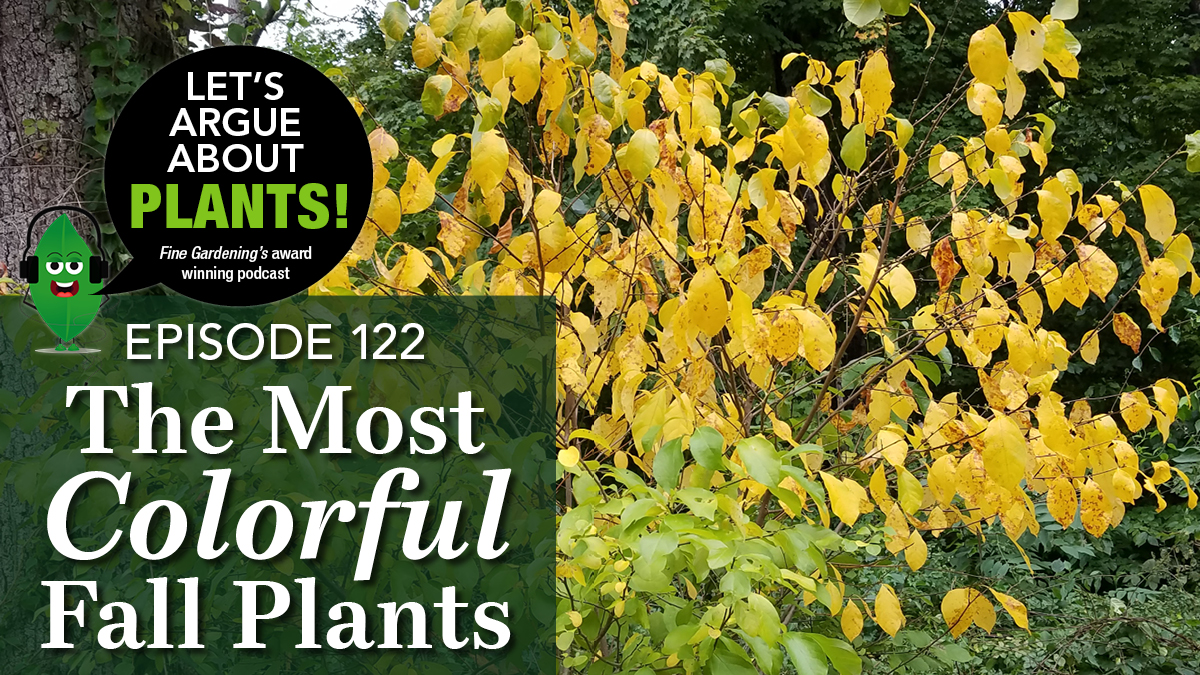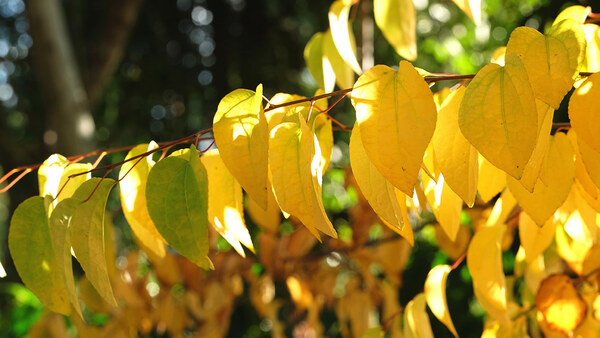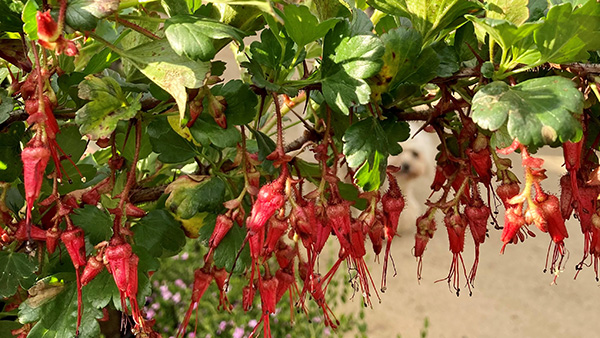
Having grown up in New England, and living there now, I consider myself pretty spoiled in fall. After all, tourists literally flock to my section of North America every autumn to take in the sight of the native forests turning brilliant colors. We even have a term for these folks: leaf peepers. As I write this, I’m looking out my window at a sassafras (Sassafras albidum, Zones 4–9) that looks like someone lit it on fire. The orange, yellow, and red foliage glows so brightly that at certain times of day, the walls of my office turn a similar color simply from the intensity. Trees with the best fall color are not limited to New England, however.

There are large and small woodies that will shift to a brilliant shade of citrus or deep ruby for nearly every corner of the country. Even if your nighttime temperatures don’t fall that low, a bit of a chill is all that is needed in many cases to spark a notable color change with certain deciduous trees. The following is a balanced mix of trees with excellent fall color. You’ll find natives and nonnatives, large and small habits, and an array of hardiness levels. So whether you live in South Carolina or Southern California—or anywhere in between—chances are there is an amazing tree you can grow for autumnal foliar beauty. And planting one of these options will save you the cost of traveling to New England this season.

1. Red maple
Name: Acer rubrum
Zones: 3–9
Size: 40 to 65 feet tall and 30 to 45 feet wide
Conditions: Full sun to partial shade; moist to wet, well-drained soil
Native range: Eastern and central North America
When you think of the East Coast in fall, you think of two trees for fall color: sugar maple (Acer saccharum, Zones 3–9) and red maple. The latter is more impressive in my mind; it slowly shifts its foliage from a glossy green to a deep, blood red. In fact, you’ll sometimes notice a mottled effect on the leaves before they shift completely to dark red and then steadily brighten to a fire engine hue before dropping in late fall. This tree prefers wet soil conditions (its other common name is “swamp maple”), although it will tolerate drier conditions once established. This is a medium-size, deciduous tree that is native to eastern North America from Quebec to Minnesota and south to Florida and eastern Texas. The clusters of lovely, bright red, Sputnik-like flowers that appear along the branches in late winter are generally one of the first signs that spring is on the doorstep.

2. ‘Horstmann’s Recurved’ European larch
Name: Larix decidua ‘Horstmann’s Recurved’
Zones: 2–7
Size: 8 feet tall and 4 feet wide
Conditions: Full sun to partial shade; well-drained soil
Native range: Central and Southern Europe
You’ll never regret planting any type of larch. This is one of a rare few conifers that are deciduous, shedding all their needles yearly. The needles emerge a bright green in spring and are amazingly soft. As the tree ages, it develops weeping branches that look much like the sleeves of a Stevie Nicks dress in the 1970s. ‘Horstmann’s Recurved’ adds to that character, with each branch twisting irregularly in every direction. With the onset of the first chilly nights in autumn, the soft green needles will turn a brilliant yellow and then gracefully mellow to a buttery gold. In the warmer end of its zonal hardiness, the golden needles may hang on into winter. Regardless, once they drop, you’re left with an incredible living garden sculpture to carry you through the winter.

3. Flame Thrower® Eastern redbud
Name: Cercis canadensis ‘NC2016-2’
Zones: 5–9
Size: 15 to 20 feet tall and 15 feet wide
Conditions: Full sun to partial shade; moist, well-drained soil
Native range: Eastern and central North America
Who doesn’t love a redbud? This is by far one of the best native trees out there for myriad reasons. The silvery bark is divine, the magenta-to-soft-lavender flowers (which appear before the foliage) are spectacular, and the heart-shaped kelly green leaves are darling. The straight species, which is native to at least half the country, is great all on its own. But if you want to up your redbud game, you should try Flame Thrower®. Relatively new to nurseries, this nativar has foliage that emerges burgundy, fades to yellow, and eventually matures to green. And the branches display all the colors at once! Just when you think the show can’t get any better, in fall the foliage turns lemon yellow overnight and holds for several weeks. Planting one of these small trees in a front yard would be like planting a ray of sunshine.

4. Japanese stewartia
Name: Stewartia pseudocamellia
Zones: 5–8
Size: 20 to 40 feet tall and 15 to 30 feet wide
Conditions: Full sun; moist, well-drained soil
Native range: Japan
Rare is the tree that is truly a four-season wonder. One exception is Japanese stewartia. As the tree matures the bark begins to peel, revealing strips of silver, tan, and near white along the trunk and larger branches. In spring, medium green, oval leaves appear and have a bit of fuzz on them, which helps keep hungry deer away. Then in summer you’ll wonder if you forgot that you planted a camellia (Camellia spp. and cvs., Zones 7–10) because Japanese stewartia bursts into flower with delicate white, cupped blooms with golden centers. If this tree stopped performing at this point, you’d still want it, right? But wait, there’s more! In fall the stewartia turns into a version of Joseph’s Technicolor dream coat, with foliage that shifts from orange-yellow, to bright pink-red, to a rich copper mahogany. This is largely a pest- and disease-free woody plant, and it needs only well-drained soil to be happy.

5. Franklin tree
Name: Franklinia alatamaha
Zones: 5–8
Size: 10 to 20 feet tall and 6 to 15 feet wide
Conditions: Full sun to partial shade; moist, well-drained soil
Native range: Southeastern United States
If you’re looking for stunning foliage and flowers in fall, look no further than Franklin tree. John Bartram, a botanist appointed by King George III in 1765 to explore North America, first discovered Franklinia growing along the Altamaha River in southeastern Georgia. Bartram collected seed and successfully began growing Franklin tree (named after Benjamin Franklin) back at his home base of Philadelphia. Unfortunately, this tree has been extinct in the wild since 1803, but plants continue to be cultivated by nurseries around the country. The lance-shaped leaves are around 6 inches long and are a glossy green for most of the spring and summer. Then in late summer to early fall, large cup-shaped flowers with an eye-catching golden center appear. This happens to coincide with the foliage shifting to bright orange and red. Oh, and did I mention that the flowers are fragrant? This late-season show is unlike any other in the world of woodies. Franklin tree does need consistent moisture to do well, so those with dry, lean soil need to look elsewhere for a suitable option to plant.

6. Coral bark maple
Name: Acer palmatum ‘Sango-kaku’
Zones: 5–9
Size: 20 to 25 feet tall and 15 to 20 feet wide
Conditions: Partial shade; moist, well-drained soil
Native range: Japan
Another four-season wonder, coral bark maple seldom has an ugly phase. In winter the bright pink-red stems glow against the bleak gray sky, offering a hit of color similar to that of a redtwig dogwood (Cornus servicea and cvs., Zones 3–8). Then in spring, vibrant golden leaves outlined in red appear. Although they gradually fade a bit to become more green than yellow, they still fall into the chartreuse category. The lacy texture of the canopy is a beautiful contrast to most trees. In fall, the color progression of the leaves goes backward, with the foliage changing back to an acid yellow, still edged in red. Be sure to give this small tree some shade in the late afternoon or else its delicate foliage will burn and ruin the late-season color show.

7. Early Glow™ Ohio buckeye
Name: Aesculus glabra ‘J. N. Select’
Zones: 3–7
Size: 40 feet tall and 25 feet wide
Conditions: Full sun to partial shade; moist, well-drained soil
Native range: Eastern United States and Canada
A fairly new edition to the best fall trees lineup is Early Glow™ Ohio buckeye. This tree sports yellow-green flower clusters that are quite lovely and, according to Fine Gardening regional reporter Mark Dwyer, attract scores of hummingbirds. The dark green summer foliage resists sun-scorch, which can be a big cosmetic issue for the straight species. Because the foliage stays in good form throughout July and August, come September the leaves reliably turn a brilliant red (instead of just turning completely brown and shriveling up). As with all native buckeyes, it’s best to avoid dry sites.

8. Katsura tree
Name: Cercidiphyllum japonicum
Zones: 4–8
Size: 40 to 60 feet tall and wide
Conditions: Full sun to partial shade; well-drained soil
Native range: China and Japan
You’ll swear the carnival is parked in your driveway if you plant this tree. When its teardrop-shaped green leaves shift to bright yellow in fall, they emit a fragrance that smells like maple sugar or cotton candy. This is a deciduous tree that can be grown as a single- or multi-trunked specimen. The canopy is rounded, giving the tree a lollipop look and hinting at the olfactory delight that waits in autumn. The foliage emerges red in spring before gradually maturing to bright green. Its bark develops a muscular, reddish look with age, which adds some interest in winter. Although pretty easy to care for, young katsuras resent dry soil, so be sure to keep newly planted trees evenly moist for the first few years.
For more on spectacular fall trees, click here.
—Danielle Sherry is the executive editor.
Photos, except where noted: Danielle Sherry


















Comments
Log in or create an account to post a comment.
Sign up Log in